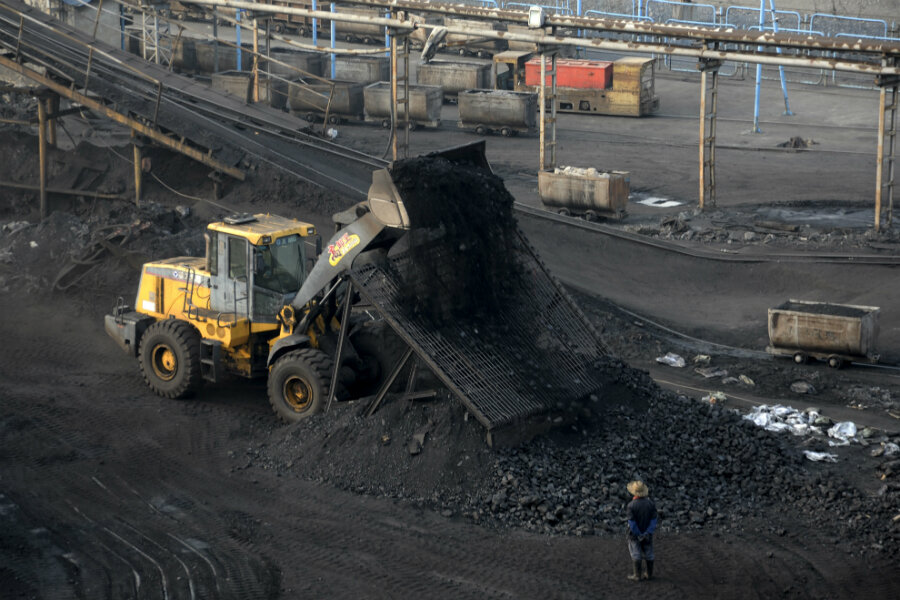China's coal consumption drops again, boosting its leadership on climate change
Loading...
| Beijing
The latest sign of China’s emergence as a world leader in addressing climate change came Tuesday when the government released data showing that the country’s coal consumption dropped in 2016 for a third year in a row.
Hours later in Washington, President Trump signed an executive order aimed at rolling back one of former President Obama’s major environmental regulations on clean water. His administration is also expected to take aim at Mr. Obama’s signature 2015 climate change regulation on greenhouse gas emissions in coming weeks.
The United States and China became critical partners in the fight against global warming during the Obama administration, crucially joining last year to endorse the landmark Paris climate accord. But their paths have diverged since the Trump took over the White House in January.
Trump’s change in tack has provided China – the world’s biggest emitter of greenhouse gases – the opportunity to lead on climate change by reducing its dependency on coal in favor of natural gas and renewable energy. (Coal consumption in the US has also declined, mainly because of a glut in the global steel market and cheap natural gas.)
Li Shuo, a climate policy analyst at Greenpeace East Asia, says Beijing has embraced its role as a leader on climate change as it works to shift its economy away from heavy industries toward more consumer-based growth.
“The fundamentals of the economy in China are very favorable for climate action,” Mr. Li says. “We’re now missing the diplomatic engine from Washington. China has a good opportunity to step up its game.”
Preliminary calculations from China’s National Bureau of Statistics show that the country’s coal consumption fell by 4.7 percent last year. The bureau said the share of coal in China’s total energy consumption mix fell to 62 percent in 2016 from 64 percent the year before.
An analysis by Greenpeace East Asia predicts that China’s total carbon dioxide (CO2) emissions will drop 1 percent in 2017, the fourth year in a row of either zero growth or a decline. A 1.3 percent decline in coal consumption in 2016 helped keep CO2 emissions steady for the year.
China’s efforts to curb emissions stand in stark contrast to Trump’s pledge to revitalize the American coal industry. In February, he eliminated a regulation established by the Obama administration that restricts coal companies from dumping mining waste into streams and waterways. Trump claimed the move would save 77,000 jobs, a widely disputed figure.
Trump has called climate change a hoax perpetrated by the Chinese and picked Scott Pruitt, a fierce opponent of Obama’s rules to reduce greenhouse gas emissions, to lead the Environmental Protection Agency. Mr. Pruitt has wasted little time in his new job. On Thursday, the EPA announced plans to withdraw an Obama-era request that oil and natural gas companies provide information on methane emissions. The US is the world’s second largest emitter of man-made emissions behind China, and methane has a global warming potential more than 25 times greater than that of CO2.
In the face of American retrenchment on climate change, China can play an important role in implementing the Paris agreement, says Ma Tianjie, managing editor of China Dialogue, an English- and Chinese-language website that focuses on the environment.
“This is where China is going to show its leadership,” he says. “By providing confidence to the global community.”
Closing mines
Reforms to the coal industry are central to Beijing’s climate campaign. For years, the government has ordered the closing of smaller and less efficient coal mines in an effort to boost productivity in the sector. It far exceeded its goal of eliminating 250 million tons of excess coal capacity last year. In January, the National Energy Administration ordered the cancellation of 103 coal-fired power plants planned across the country.
But China faces a growing set of challenges as it pushes to further rein in the coal industry. As the government begins to target larger operational mines, it faces the daunting task of laying off hundreds of thousands of workers and finding them new jobs.
Jiang Kejun, a senior researcher at the Energy Research Institute, part of China’s Economic Development Agency, says the government will need to “carefully design the road map” for restructuring both industries – no easy task given their enormous size.
Yin Weimin, the minister of human resources and social security, said Wednesday that China will cut 500,000 steel and coal jobs this year. It cut about 726,000 related jobs in 2016, provoking protests in places like northern Hebei province.
“Unemployment is a very hard thing to solve in communities that have depended on coal for a long time,” says Zhao Ang, director of Rock Environment and Energy Institute, a Beijing-based think tank. “You need to think about the livelihoods of people in those areas.”
Meanwhile, China is pursuing renewable energy sources like solar and wind as it positions itself to dominate one of the world’s fastest-growing industries. Earlier this year, the National Energy Administration announced plans to spend more than $360 billion through 2020 on clean energy, which made up 19.7 percent of China’s total energy consumption mix in 2016.
China’s aggressive push has put it on track to hit the goals it announced as part of the Paris accord much earlier than its initial targets, according to Greenpeace East Asia. China pledged that by 2020, the level of CO2 emissions per unit of GDP will be 18 percent lower than in 2015. It also guaranteed that emissions will peak no later than 2030.
Li of Greenpeace says he doesn’t doubt China’s commitment to achieving its climate goals. The harder question to answer is whether the US will keep its promises under the Trump administration.
“The US and China play such an important role that in the long run there is no climate solution without the cooperation of these two countries,” Li says.





